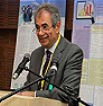The curse of dependency: Examining structural change in African economies
Abstract
This study investigates the effect of external dependency on structural change in 54 African countries between 1990 and 2021. The Two-Step System Generalized Method of Moments strategy is adopted to control for potential endogeneity problems. Findings reveal that structural change in Africa is strongly impaired by the level of external dependency. This is since all proxies of external dependency are negatively and statistically significant with all structural change proxies. For instance, under agricultural productivity, external debts stocks (EDS) give an eigen value (β) of 0.879, standard coefficient (SC) = 0.162, and p = 0.000; for external debt services (DSED), β = 0.240, SC = −0.040, and p = 0.972; and for personal remittances received (PRR), we have β = 0.764, SC = −0.133, and p = 0.031. Depicting that, the more African countries rely on the external world for change, the less they realize this change. The results remain consistent after accounting for income differences by segmenting African countries into low- and middle-income groups. As suggestions to policymakers, for structural change to concretely take place in Africa, the rate of external dependence should be limited, and resources in Africa and local methods of growth should be used rather than copying from the Western world. Though the results are valid across income groups and Africa, the case of countries could be more significant.
References
[1]Uy T, Yi KM, Zhang J. Structural change in an open economy. Journal of Monetary Economics. 2013; 60(6): 667-682. doi: 10.1016/j.jmoneco.2013.06.002
[2]Mukwege D. The Nobel Peace Prize 2018: “Nobel Lecture”. Available online: https://www.nobelprize.org/prizes/peace/2018/mukwege/lecture/ (accessed on 1 December 2024).
[3]Buera FJ, Kaboski JP, Shin Y. Finance and Development: A Tale of Two Sectors. American Economic Review. 2011; 101(5): 1964-2002. doi: 10.1257/aer.101.5.1964
[4]Buera FJ, Oberfield E. The Global Diffusion of Ideas. Econometrica. 2020; 88(1): 83-114. doi: 10.3982/ecta14044
[5]Bustos P, Caprettini B, Ponticelli J. Agricultural Productivity and Structural Transformation: Evidence from Brazil. American Economic Review. 2016; 106(6): 1320-1365. doi: 10.1257/aer.20131061
[6]Triplet JE, Bosworth BP. Productivity in the US services sector: new sources of economic growth. Brookings Institution Press; 2004.
[7]Gbemenou B, Doukkali MR, Aloui O. The determinants of structural transformation in Africa (French). Moroccan Journal of Agriculture and Veterinary Medicine. 2020; 8(3): 371–380.
[8]Herrendorf B, Rogerson R, Valentinyi Á. Growth and Structural Transformation. In: Handbook of Economic Growth. Elsevier; 2014. pp. 855-941.
[9]Maclaren VW. Urban Sustainability Reporting. Journal of the American Planning Association. 1996; 62(2): 184-202. doi: 10.1080/01944369608975684
[10]Syrquin M, Chenery HB. Patterns of Development, 1950 to 1983. World Bank Washington, DC. 1989.
[11]Wantchekon L. Why do resource abundant countries have authoritarian governments? Journal of African Development. 2002; 5(2): 145-176.
[12]Fereira SB, Cateia JV. Trade reform, infrastructure investment, and structural transformation in Africa: Evidence from Guinea-Bissau. Emerging Markets Review. 2023; 55: 101027. doi: 10.1016/j.ememar.2023.101027
[13]Herrendorf B, Valentinyi Á. Which sectors make poor countries so unproductive? Journal of the European Economic Association. 2012; 10(2): 323-341. doi: 10.1111/j.1542-4774.2011.01062.x
[14]Wung AE, Kountchou AM, Nanfosso RT. Tourism arrival in Africa: An empirical investigation. Annals of Tourism Research Empirical Insights. 2023; 4(1): 100098. doi: 10.1016/j.annale.2023.100098
[15]Chenery H, Robinson S, Syrquin M. Industrialization and growth: A Comparative Study. New York: Oxford University Press; 1986. p. 387.
[16]Buera FJ, Kaboski JP. The Rise of the Service Economy. American Economic Review. 2012; 102(6): 2540-2569. doi: 10.1257/aer.102.6.2540
[17]Ngai LR, Petrongolo B. Gender Gaps and the Rise of the Service Economy. American Economic Journal: Macroeconomics. 2017; 9(4): 1-44. doi: 10.1257/mac.20150253
[18]Vicente Cateia J, Bittencourt MVL, Carvalho TS, et al. The impacts of agricultural productivity on structural transformation, and poverty alleviation in Africa: evidence from Guinea-Bissau. Journal of Productivity Analysis. 2023; 61(3): 305-320. doi: 10.1007/s11123-023-00703-1
[19]Avom D, Keneck-Massil J, Njangang H, et al. Why are some resource-rich countries more sophisticated than others? The role of the regime type and political ideology. Resources Policy. 2022; 79: 103067. doi: 10.1016/j.resourpol.2022.103067
[20]Zeufack AG, Calderon C, Kambou G, et al. Africa’s Pulse, No. 22, Fall 2020. World Bank Publications; 2020.
[21]African Development Bank Group. AfDB Annual Report 2016. Available online: https://www.afdb.org/fr/documents/document/afdb-annual-report-2016-95954 (accessed on 1 December 2024).
[22]International Monetary Fund. Sustaining Long-Run Growth and Macroeconomic Stability in Low-Income Countries—The Role of Structural Transformation and Diversification. Policy Papers. 2014; 2014(38). doi: 10.5089/9781498343688.007
[23]Donovan K. Agricultural risk, intermediate inputs, and cross-country productivity differences. Economics, Agricultural and Food Sciences. 2012. doi: 10.2139/ssrn.2253517
[24]Avom D, Nguekeng B. The Structural Transformation of Sub Saharan Africa’s Economy: What is the Role of Global Value Chains? (French). Development Economics Review. 2022; 28(4): 5-46. doi: 10.3917/edd.344.0005
[25]Rodrik D. Premature deindustrialization. Journal of Economic Growth. 2015; 21(1): 1-33. doi: 10.1007/s10887-015-9122-3
[26]Dorosh P, Thurlow J. Can Cities or Towns Drive African Development? Economywide Analysis for Ethiopia and Uganda. World Development. 2014; 63: 113-123. doi: 10.1016/j.worlddev.2013.10.014
[27]Djontu BL. Determinants and potential of Cameroon’s agricultural product exports: An application of the stochastic frontier gravity model (French). Munich Personal RePEc Archive. 2022.
[28]Chandra V, Li Y, Osorio-Rodarte I. Commodity Export Diversification in Rwanda—Many Export Discoveries with Little Scaling-Up. SSRN Electronic Journal. 2007. doi: 10.2139/ssrn.2277015
[29]de Brauw A, Mueller V, Lee HL. The Role of Rural–Urban Migration in the Structural Transformation of Sub-Saharan Africa. World Development. 2014; 63: 33-42. doi: 10.1016/j.worlddev.2013.10.013
[30]Chen S, Jefferson GH, Zhang J. Structural change, productivity growth and industrial transformation in China. China Economic Review. 2011; 22(1): 133-150. doi: 10.1016/j.chieco.2010.10.003
[31]Aggarwal R. Comparative Analysis of Structural Transformation Process of Selected Asian Developing Economies. Journal of Asian Economic Integration. 2021; 3(1): 7-24. doi: 10.1177/2631684621989809
[32]Ghose AK. Structural transformation of India’s economy. Institute for Human Development. 2020.
[33]Zalk N. Structural Change in South Africa: A Historical Sectoral Perspective. In: Andreoni A, Mondliwa P, Roberts S, Tregenna F (editors). Structural transformation in South Africa: The challenges of inclusive industrial development in a middle-income country. Oxford Academic; 2021. p. 28.
[34]Andreoni A, Mondliwa P, Roberts S, Tregenna F. Framing structural transformation in South Africa and beyond. In: Andreoni A, Mondliwa P, Roberts S, Tregenna F (editors). Structural Transformation in South Africa: The Challenges of Inclusive Industrial Development in a Middle-Income Country. Oxford Academic; 2021. pp. 1-27.
[35]Ngai R, Olivetti C. Petrongolo B. Structural Transformation over 150 years of Women’s and Men’s Work. Economics, Sociology. 2022.
[36]UN. ESCAP. Structural transformation and its role in reducing poverty. Economic and Social Commissionfor Asia and the Pacific. 2019.
[37]Barrett CB, Ortiz-Bobea A, Pham T. Structural Transformation, Agriculture, Climate, and the Environment. Review of Environmental Economics and Policy. 2023; 17(2): 195-216. doi: 10.1086/725319
[38]Buera FJ, Kaboski JP. Scale and the origins of structural change. Journal of Economic Theory. 2012; 147(2): 684-712. doi: 10.1016/j.jet.2010.11.007
[39]Martins PMG. Structural change: Pace, patterns and determinants. Review of Development Economics. 2018; 23(1): 1-32. doi: 10.1111/rode.12555
[40]Lewis WA. Economic Development with Unlimited Supplies of Labour. The Manchester School. 1954; 22(2): 139-191. doi: 10.1111/j.1467-9957.1954.tb00021.x
[41]Government of Cameroon. Growth and Employment Strategy Paper (GESP) for 2010–2020. Government of Cameroon. 2009.
[42]UNWTO. Supporting jobs and economies through travel & tourism—a call for action to mitigate the socio-economic impact of COVID-19 and accelerate recovery. UNWTO. 2020.
[43]Atolia M, Loungani P, Marquis M, et al. Rethinking development policy: What remains of structural transformation? World Development. 2020; 128: 104834. doi: 10.1016/j.worlddev.2019.104834
[44]Busse M, Erdogan C, Mühlen H. Structural transformation and its relevance for economic growth in Sub‐Saharan Africa. Review of Development Economics. 2018; 23(1): 33-53. doi: 10.1111/rode.12543
[45]Kong L, Sofuoğlu E, Ishola BD, et al. Sustainable development through structural transformation: a pathway to economic, social, and environmental progress. Economic Change and Restructuring. 2024; 57(2). doi: 10.1007/s10644-024-09583-3
[46]Rohit K. Global value chains and structural transformation: Evidence from the developing world. Structural Change and Economic Dynamics. 2023; 66: 285-299. doi: 10.1016/j.strueco.2023.05.006
[47]Zhang K. Economic Structural Transformation in Emerging Market Countries. Global Journal of Emerging Market Economies. 2021; 13(2): 216-238. doi: 10.1177/09749101211004614
[48]Koo AYC. Economic Growth and Structural Change in Taiwan—The Postwar Experience of the Republic of China. The Journal of Asian Studies. 1980; 40(1): 109-110. doi: 10.2307/2055049
[49]Oyelaran-Oyeyinka B. Resurgent Africa: Structural transformation in sustainable development. Anthem Press; 2020.
[50]Liu Z, Ling Y. Structural transformation, TFP and high-quality development. China Economist. 2022; 17(1): 70-82.
[51]Solow RM. A Contribution to the Theory of Economic Growth. The Quarterly Journal of Economics. 1956; 70(1): 65. doi: 10.2307/1884513
[52]Eberhardt M, Teal F. Structural Change and Cross-Country Growth Empirics. The World Bank Economic Review. 2012; 27(2): 229-271. doi: 10.1093/wber/lhs020
[53]McMillan M, Rodrik D, Sepulveda C. Structural Change, Fundamentals and Growth: A Framework and Case Studies. National Bureau of Economic Research. 2017. doi: 10.3386/w23378
[54]McMillan M, Rodrik D, Verduzco-Gallo Í. Globalization, Structural Change, and Productivity Growth, with an Update on Africa. World Development. 2014; 63: 11-32. doi: 10.1016/j.worlddev.2013.10.012
[55]Chenery HB. Patterns of industrial growth. The American economic review. 1960; 50(4): 624-654.
[56]Kuznets SS. Modern economic growth. Yale University Press; 1966.
[57]Gbemenou B, Doukkali MR, Aloui O. Determinants of Structural Transformation in Africa (French). Moroccan Journal of Agronomic and Veterinary Sciences. 2020; 8(3): 371–380.
[58]Monga C, Lin JY. Structural transformation—overcoming the curse of destiny. In: The Oxford Handbook of Structural Transformation. Oxford University Press; 2019. pp. 1-32.
[59]Caselli F. Accounting for cross-country income differences. In: Handbook of economic growth. Elsevier; 2005. pp. 679-741.
[60]Duarte M, Restuccia D. The Role of the Structural Transformation in Aggregate Productivity. Quarterly Journal of Economics. 2010; 125(1): 129-173. doi: 10.1162/qjec.2010.125.1.129
[61]McMillan M, Headey D. Introduction—Understanding Structural Transformation in Africa. World Development. 2014; 63: 1-10. doi: 10.1016/j.worlddev.2014.02.007
[62]Marouani MA, Mouelhi R. Contribution of structural change to productivity growth: Evidence from Tunisia. Journal of African Economies. 2016; 25(1): 110-132. doi: 10.1093/jae/ejv016
[63]Porzio T, Rossi F, Santangelo G. The Human Side of Structural Transformation. American Economic Review. 2022; 112(8): 2774-2814. doi: 10.1257/aer.20201157
[64]Zhao J, Sinha A, Inuwa N, et al. Does structural transformation in economy impact inequality in renewable energy productivity? Implications for sustainable development. Renewable Energy. 2022; 189: 853-864. doi: 10.1016/j.renene.2022.03.050
[65]McMillan M, Rodrik D. Globalization, Structural Change and Productivity Growth. National Bureau of Economic Research. 2011. doi: 10.3386/w17143
[66]Dorosh PA, Minten B. Structural transformation and the agricultural food system: An introduction. In: Dorosh PA, Minten B (editors). Ethiopia’s agrifood system: Past trends, present challenges, and future scenarios. International Food Policy Research Institute, Washington, DC; 2020. p. 1.
[67]Emako E, Nuru S, Menza M. The effect of foreign direct investment on structural transformation in developing countries. Cogent Economics & Finance. 2022; 10(1). doi: 10.1080/23322039.2022.2125658
[68]Collier P, Dercon S. African Agriculture in 50Years: Smallholders in a Rapidly Changing World? World Development. 2014; 63: 92-101. doi: 10.1016/j.worlddev.2013.10.001
[69]Christiaensen L, Todo Y. Poverty Reduction During the Rural–Urban Transformation—The Role of the Missing Middle. World Development. 2014; 63: 43-58. doi: 10.1016/j.worlddev.2013.10.002
[70]Conway G, Shah R. One Billion Hungry: Can We Feed the World? Comstock Publishing Associates; 2012. p. 456.
[71]Bräutigam D, Tang X. “Going Global in Groups”: Structural Transformation and China’s Special Economic Zones Overseas. World Development. 2014; 63: 78-91. doi: 10.1016/j.worlddev.2013.10.010
[72]Harrison AE, Lin JY, Xu LC. Explaining Africa’s (Dis) Advantage: The Curse of Party Monopoly. The World Bank. 2013. doi: 10.1596/1813-9450-6316
[73]Kaldor N. Marginal Productivity and the Macro-Economic Theories of Distribution: Comment on Samuelson and Modigliani. The Review of Economic Studies. 1966; 33(4): 309. doi: 10.2307/2974428
[74]Rodrik D. Why we learn nothing from regressing economic growth on policies. Seoul Journal of Economics. 2012; 25(2): 137-151.
[75]Nguimkeu P, Zeufack AG. Manufacturing in Structural Change in Africa. World Bank. 2019.
[76]Hidalgo CA, Klinger B, Barabási AL, et al. The Product Space Conditions the Development of Nations. Science. 2007; 317(5837): 482-487. doi: 10.1126/science.1144581
[77]Lin JY. New Structural Economics-A Framework for Rethinking Development and Policy. World Bank; 2012.
[78]United Nations Industrial Development Organization (UNIDO). Industrial Development Report 2013—Sustaining Employment Growth: The Role of Manufacturing and Structural Change. United Nations Industrial Development Organization. 2014.
[79]Lectard P. Value chains and sustainable structural transformation. African Development Bank Abidjan. 2017.
[80]Baldwin R. Global supply chains: why they emerged, why they matter, and where they are going. Fung Global Institute. 2012.
[81]Lederman D, Maloney WF. Does what you export matter?: In search of empirical guidance for industrial policies. World Bank Publications; 2012.
[82]Banerjee AV, Duflo E. Growth theory through the lens of development economics. In: Aghion P, Durlauf S (editor). Handbook of economic growth. North Holland; 2006. pp. 473-552.
[83]World-Bank. World Developement Indicators. Available online: https://databank.worldbank.org/source/world-development-indicator (accessed on 1 December 2024).
[84]Roodman D. A Note on the Theme of Too Many Instruments. Oxford Bulletin of Economics and Statistics. 2009; 71(1): 135-158. doi: 10.1111/j.1468-0084.2008.00542.x
[85]Blundell R, Bond S. Initial conditions and moment restrictions in dynamic panel data models. Journal of econometrics. 1998; 87(1): 115-143.
[86]Arellano M, Bover O. Another look at the instrumental variable estimation of error-components models. Journal of econometrics. 1995; 68(1): 29-52.
[87]Windmeijer F. A finite sample correction for the variance of linear efficient two-step GMM estimators. Journal of Econometrics. 2005; 126(1): 25-51. doi: 10.1016/j.jeconom.2004.02.005
[88]Kouladoum JC, Wirajing MAK, Nchofoung TN. Digital technologies and financial inclusion in Sub-Saharan Africa. Telecommunications Policy. 2022; 46(9): 102387. doi: 10.1016/j.telpol.2022.102387
[89]Nchofoung TN, Asongu SA, Njamen Kengdo AA, et al. Linear and non‐linear effects of infrastructures on inclusive human development in Africa. African Development Review. 2022; 34(1): 81-96. doi: 10.1111/1467-8268.12619
[90]Skrbková D, Rydvalová P. Entrepreneurial Intentions: A Comparative Study of African and European University Economics Students. Journal of African Business. 2023; 25(4): 792-810. doi: 10.1080/15228916.2023.2276541
[91]Anderson K, Ponnusamy S. Structural transformation to manufacturing and services: what role for trade? Asian Development Review. 2019; 36(2): 32-71. doi: 10.1162/adev_a_00131
[92]Bloom N, Van Reenen J. Measuring and Explaining Management Practices Across Firms and Countries. The Quarterly Journal of Economics. 2007; 122(4): 1351-1408. doi: 10.1162/qjec.2007.122.4.1351
[93]Dul J. Conducting necessary condition analysis for business and management students. Sage; 2019.
[94]Dul J, Hauff S, Tóth Z. Necessary condition analysis in marketing research. In: Nunkoo R, Teeroovengadum V, Ringle C (editors). Handbook of Research Methods for Marketing Management. Edward Elgar Publishing; 2021. p. 51-72.
[95]Dul J, Karwowski M, Kaufman JC. Necessary condition analysis in creativity research. In: Handbook of research methods on creativity. Edward Elgar Publishing; 2020. p. 351-368.
[96]Khan GF, Sarstedt M, Shiau WL, et al. Methodological research on partial least squares structural equation modeling (PLS-SEM). Internet Research. 2019; 29(3): 407-429. doi: 10.1108/intr-12-2017-0509
[97]Gudergan SP, Ringle CM, Wende S, et al. Confirmatory tetrad analysis in PLS path modeling. Journal of Business Research. 2008; 61(12): 1238-1249. doi: 10.1016/j.jbusres.2008.01.012
[98]Hair JF, Ringle CM, Sarstedt M. PLS-SEM: Indeed a Silver Bullet. Journal of Marketing Theory and Practice. 2011; 19(2): 139-152. doi: 10.2753/mtp1069-6679190202
[99]Hoyle RH, Smith GT. Formulating clinical research hypotheses as structural equation models: A conceptual overview. Journal of Consulting and Clinical Psychology. 1994; 62(3): 429-440. doi: 10.1037/0022-006x.62.3.429
[100]Hair Jr JF, Sarstedt M, Hopkins L, G. Kuppelwieser V. Partial least squares structural equation modeling (PLS-SEM). European Business Review. 2014; 26(2): 106-121. doi: 10.1108/ebr-10-2013-0128
Copyright (c) 2025 Author(s)

This work is licensed under a Creative Commons Attribution 4.0 International License.







.jpg)
.jpg)

